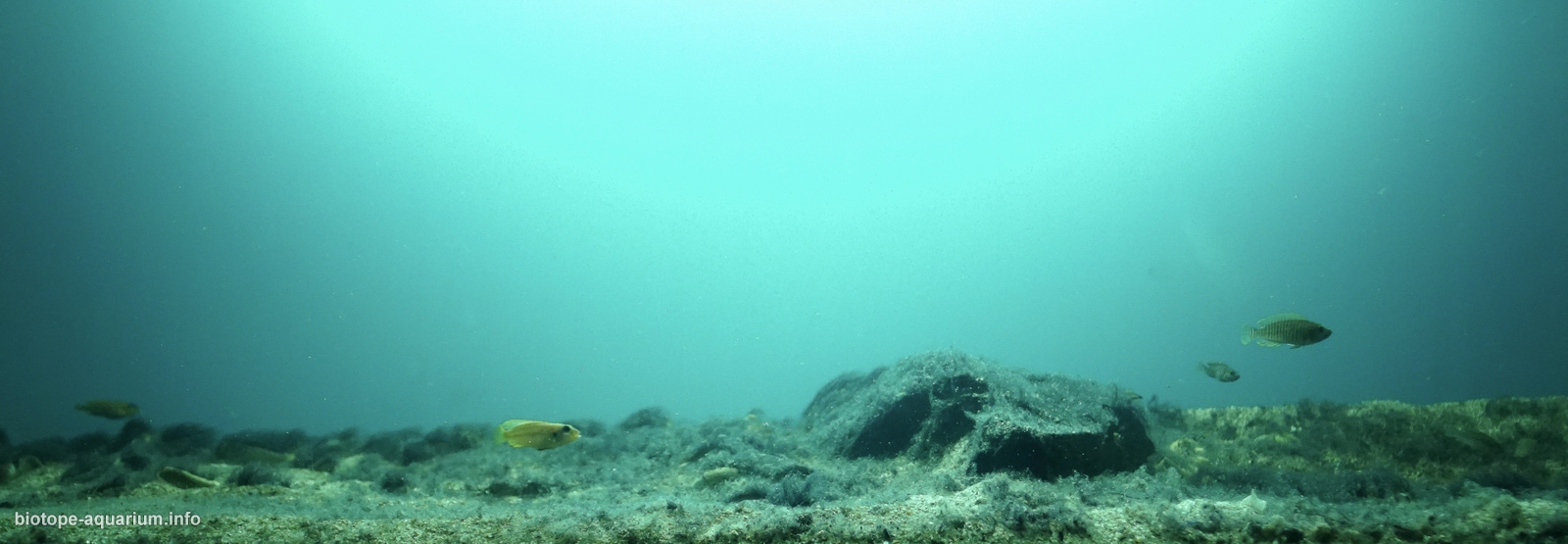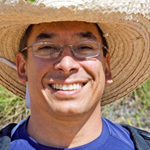Lake Tanganyika. Sandy sedimentary bottom area in Ndole Bay. Zambia
21st place in Biotope Aquarium Design Contest 2017
![]() Argentina. Walter Vazquez
Argentina. Walter Vazquez

Volume: 200 L
Dimensions: 100x50x40 cm
List of fishes: This aquarium is inhabited by two small species of shell dwellers. One of them is Neolamprologus multifasciatus (Boulenger, 1906), this small species forms colonies around shell formations, where a male lives and reproduces with several females. The parents live together with their young, who care until they become young and then integrate into the colony. The other species is Lamprologus ocellatus (Steindachner, 1909), these prefer to move away and form pairs in less populated areas, where the female selects a shell to establish her home and future breeding place. They prefer the sandy sedimentary areas where they establish their territories and homes.
In this aquarium these two named species coexist perfectly without problems, since each of them took a specific place and sector and moved away from the other, and I can experience its behavior as much as the interaction with the environment, its feeding and reproduction, as if they were in their natural hábitat.
List of plants: N/A
Description of decorations: For the decoration of the aquarium use sands of various sizes, looking more natural. Look for a visual presence with a single rock, which also acts as a delimiter of territories. The empty shells of snails used were chosen for their correct functionality, since in my country it is not possible to get empty shells of Neothauma snails. lgae were generated by means of illumination, to cover sand, snail shells and rock, in order to be able to resemble the chosen biotope.
The lighting of the aquarium was also worked with different spectra of led light, to give a feeling of depth.
Description of equipment: It is filtered by an Atman 3336 canister with biological and mechanical material. The water heating is given by an Eheim Thermocontrol of 200w. The lighting of the aquarium is based on 6500K LED tubes, and individual LEDs for the search of sub aquatic color temperature.
Water parameters: The aquarium water looks crystal clear, at a constant temperature of 24°C. The parameters of water are 9,0pH and the hardness of carbonates is 17dH. This values of pH and hardness are achieved by the addition of specific salts.
Description of the area surrounding the biotope: Lake Tanganyika is the largest of the three large lakes of the African Rift Valley, with a surface area of 32.600 km², with 673 km of length, 72 km in it´s widest point and with a coastline of 1,828 km. Its the second largest freshwater lake in the world by volume and the second deepest after lake Baikal in Siberia, with 1470m. and an average depth of 570m.
The lake is surrounded by four countries; Burundi in the Northeast, Democratic Republic of the Congo in the West, Tanzania in the East and Zambia in the South, forming a surface of 231.000 Km². Nearly one-sixth of the world’s freshwater is located on Lake Tanganyika. The lake is an important freshwater resource for people living in its vicinity.
The lake contains at least 250 species of cichlid fish (Cichlidae) and 150 other species of non-cichlid fish, most of which live on the shore of the lake, at a depth of 180 m. The lake is also an important site of study on the evolution of species. Almost all (90%) of the cichlid species of Tanganyika are endemic to the lake. This high degree of endemic species also occurs with many lake invertebrates, such as molluscs, crabs, copepods, shrimp, jellyfish, leeches, etc.
This aquarium represents the Ndole Bay area in Zambia, which is adjacent to Nkamba Bay in Nsumbu National Park on Lake Tanganyika.
Ndole Bay is part of Cameron Bay. It is located at 8 ° 28’1.14 “S of latitude and 30 ° 28’29.45” E. of longitude.
Description of the underwater landscape of the biotope: Lake Tanganyika has different habitats:
– Shallow, no sedimentary and sediment-rich shallow shores.
– The sand bottom, with little plant life.
– The muddy bottom near the rivers in flow.
– Pelagic waters, which are open waters rich in phytoplankton and zooplankton that support large banks of non-cichlid fish.
– Benthic Waters, zone of depletion of deep oxygen.
At a distance of tens of meters, the habitats of Ndole Bay change drastically, and different species evolved to adapt to them. In front of the beach, it’s found an habitat based on large rock and sand plates. Followed by these large rock plates, begins a great plain of sand. To the east, as the depth increases, the bottom of the lake has a new change, a dense area of sand and fine sediment with fields of Neothauma snail shells. In the North of the beach, two small habitats were created, each with its set of species, a coast filled by a dense canefield and rocks of little size.
On the south coast there is also a reed, but without rocks with a thick base of mud. Rock structures resembling a reef run parallel to the beach and are separated by bands of sand for only a few meters. It is a shallow area with a good water movement. A large number of fish inhabit rocky and sandy areas where they find protection, food, and their breeding grounds. Different species have different requirements in terms of territory.
Some species find protection among the rocks, and get their food from them like the Tropheus and Eretmodus; Others need sand to build their nests like Xenotilapia. Already about 200 meters from the beach is the sector of fine sand and sediment covered by a layer of empty shells of snails Neothauma tanganyicense. Some sectors also consist of dense clumps of algae in the substrate that serve as both protection for small fish or fry´s, as well as reservoirs of microorganisms that they use to feed themselves. This sector is represented in my aquarium, trying to resemble the habitat aesthetically and functionally to the cichlid species that inhabit it.
Description of the parameters of the habitat: The water in Lake Tanganyika is alkaline, with a pH between 8.5 – 9.0 depending on the depth and alkalinity surrounding the 650µS. The water temperature of the lake is very stable, due to the large body of water. The surface temperature of Lake Tanganyika ranges from 23-27°C, and the hypolimnion temperatura ranges from 23–24°C, although most fish inhabit areas with a temperature of 24-27°C.
List of fishes: The species that we can find in this area are: Altolamprologus sp. “Sumbu” (Boulenger, 1898), Lamprologus ocellatus (Steindachner, 1909), Lepidiolamprologus cunningtoni (Boulenger, 1906), Neolamprologus multifasciatus (Boulenger, 1906), Neolamprologus tetracanthus (Boulenger, 1899), Telmatochromis temporalis (Boulenger, 1898)
List of plants: N/A
Sources of information:
- Limnology and hydrology of Lakes Tanganyika and Malawi – Ruud C. M. Crul
- The Hydrology of Lake Tanganyika By C. GILLMAN – Bulletin No. 5 of GEOLOGICAL SURVEY DEPARTMENT.
- To make this aquarium inspire me and visualize many hours of uncut video from the LightSearch channel, for example this video which shaped the 7-episode documentary “Tales of Shells and Dust”. Also, to know the area corresponding to Ndole Bay, I had talks with Alfredo Reis Deus, director of the sub aquatic films and the documentary.
Comments of the members of the jury of Biotope Aquarium Design Contest 2017

The region mentioned is very accurately represented with the fish fed. Although the selected region seems easy to design because it does not contain much material, thanks to the techniques used, this handicap has been disentangle. Light use, floor use, materials and floor sedimentation, photography and video are excellent. The most realistic snail bedding I’ve seen so far. In addition, the resources you provide and the information you give are very satisfying. Congratulations.

It is true representation of the lake bed in terms of details and scenery. Looks like a shot from a documentary film. Congratulations.

I watched the next shots of a documentary about the life of shell lamprologuses in nature. Everything is very natural.

Less is more… Each time I look at this biotope aquarium I cannot stop looking at it and wonder how something so marvellous can be made from so little. After breaking my brain for a while I realize that I am probably in front of the best Lake Tanganyika setup in history. The dirty look of the benthic sediment gives it the special magic; it is just what I would expect to find in the wild. To me this is the best example that less is more. I hope my fellow judges and all the followers of this great contest saw and understood the brilliance in Walter Vazquez’s biotope aquarium.
